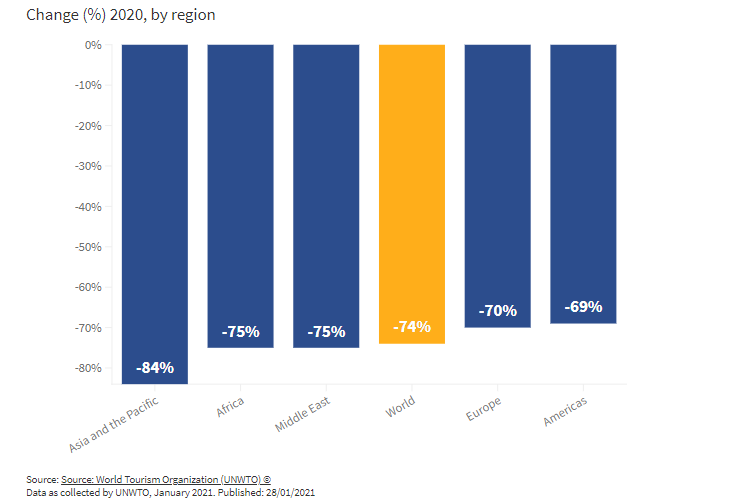The Covid-19 crisis had cost the global tourism sector over $1.3 trillion in lost revenue in 2020, making it the “worst year on record” for global tourism. International arrivals dropped by 74% according to the data from the World Tourism Organization (UNWTO).
According to the latest UNWTO World Tourism Barometer seen by Investogist, the collapse in international travel represents an estimated loss of USD 1.3 trillion in export revenues – more than 11 times the loss recorded during the 2009 global economic crisis.
as the number of people travelling plunged. In a report published on Thursday 28th January, 2021 in a report statement from the desk of the UN stating “2020 has been the worst year in tourism history”.
The secretary general of the World Tourism Organization (WTO) Zurab Pololikashvili said in a statement that, “While much has been made in making safe international travel a possibility, we are aware that the crisis is far from over”.
All world regions affected
Asia and the Pacific (-84%) – the first region to suffer the impact of the pandemic and the one with the highest level of travel restrictions currently in place – recorded the largest decrease in arrivals in 2020 (300 million fewer). The Middle East and Africa both recorded a 75% decline.

Source: UN World Tourism Organisation
Europe recorded a 70% decrease in arrivals, despite a small and short-lived revival in the summer of 2020. The region suffered the largest drop in absolute terms, with over 500 million fewer international tourists in 2020. The Americas saw a 69% decrease in international arrivals, following somewhat better results in the last quarter of the year.
A full overview of the latest global, regional and sub-regional data can be found at the UNWTO World Tourism Barometer and the UNWTO Tourism Recovery Tracker.
Recovery outlook
The latest UNWTO Panel of Experts survey shows a mixed outlook for 2021. Almost half of respondents (45%) envisaged better prospects for 2021 compared to last year, while 25% expect a similar performance and 30% foresee a worsening of results in 2021.
The overall prospects of a rebound in 2021 seem to have worsened. 50% of respondents now expect a rebound to occur only in 2022 as compared to 21% in October 2020. The remaining half of respondents still see a potential rebound in 2021, though below the expectations shown in the October 2020 survey (79% expected recovery in 2021).
As and when tourism does restart, the UNWTO Panel of Experts foresee growing demand for open-air and nature-based tourism activities, with domestic tourism and ‘slow travel’ experiences gaining increasing interest.
Looking further ahead, most experts do not to see a return to pre-pandemic levels happening before 2023. In fact, 43% of respondents point to 2023, while 41% expect a return to 2019 levels will only happen in 2024 or later.
UNWTO’s extended scenarios for 2021-2024 indicate that it could take two-and-a-half to four years for international tourism to return to 2019 levels.
Where we are now
While the invention of COVID-19 vaccines is expected to “slowly normalize travel” in 2021, many countries are reintroducing stricter travel restrictions such as quarantines, mandatory testing and complete border closures “due to the evolving nature of the pandemic” the UN body said. However, International tourism arrivals had risen by four per cent in 2019 to 1.5 billion, with France being the world’s most visited country, followed by Spain and the United States.
Earlier this month, the French government said income from tourism had dropped by €61 billion, in 2020.
Tourism minister Jean-Baptiste Lemoyne called the annual shortfall “a shock” but said that France had weathered the pandemic relatively well, thanks to visitors from neighboring countries and French people holidaying at home.
Museums were particularly hard-hit, with the Louvre in Paris reporting a drop in visitor numbers of over 70 per cent as COVID-19 restrictions kept art lovers away to curb the spread of the deadly virus.
Nnamdi Maduakor is a Writer, Investor and Entrepreneur
























































